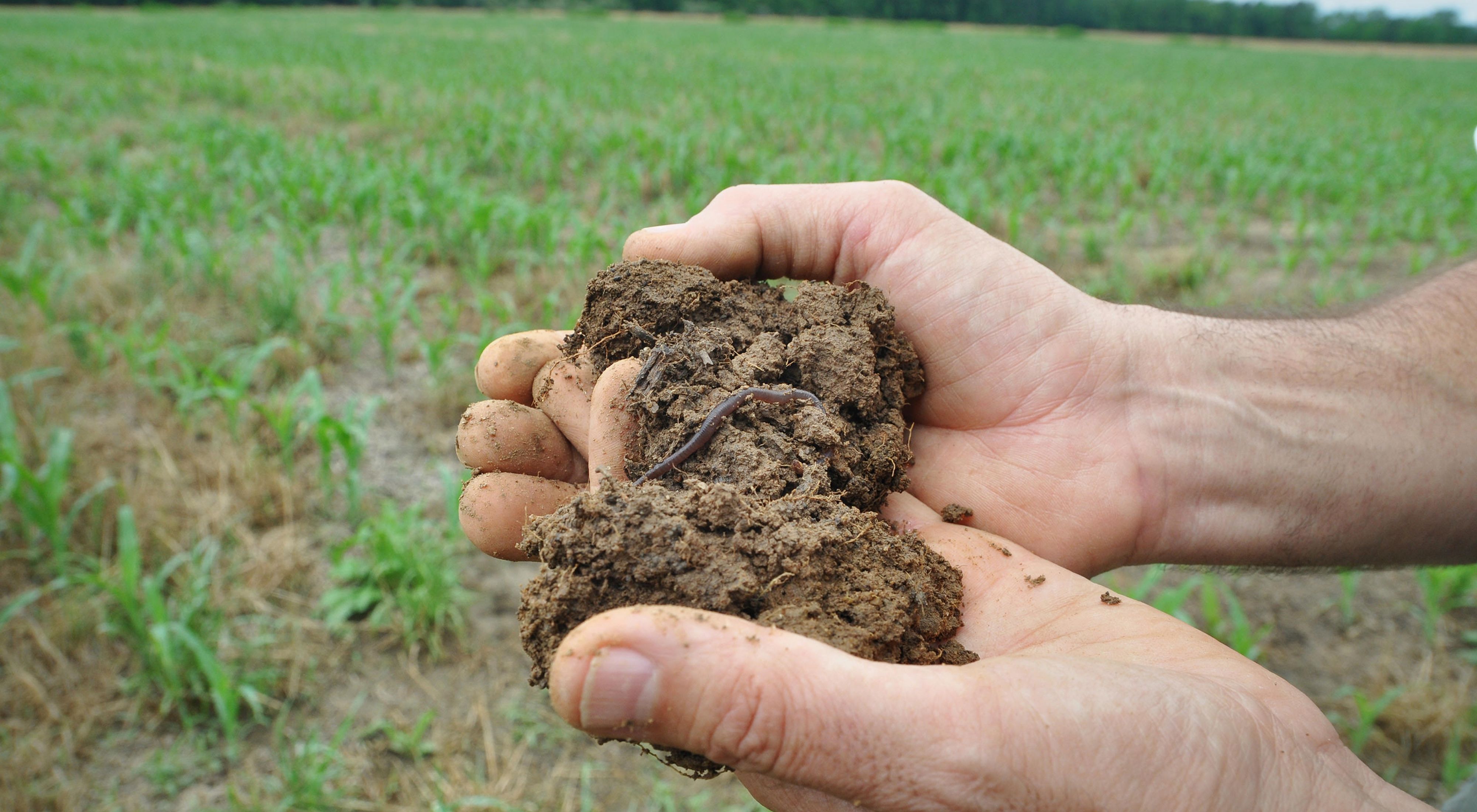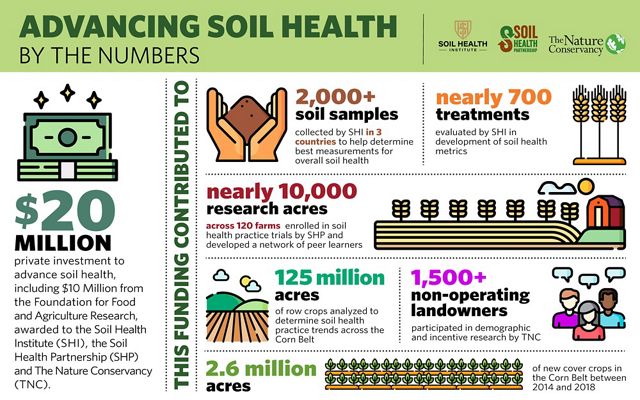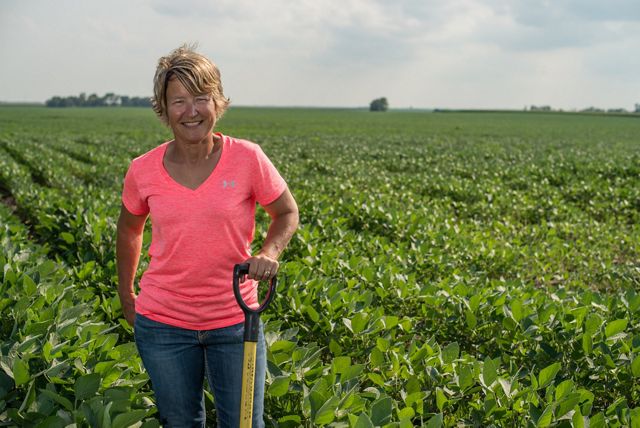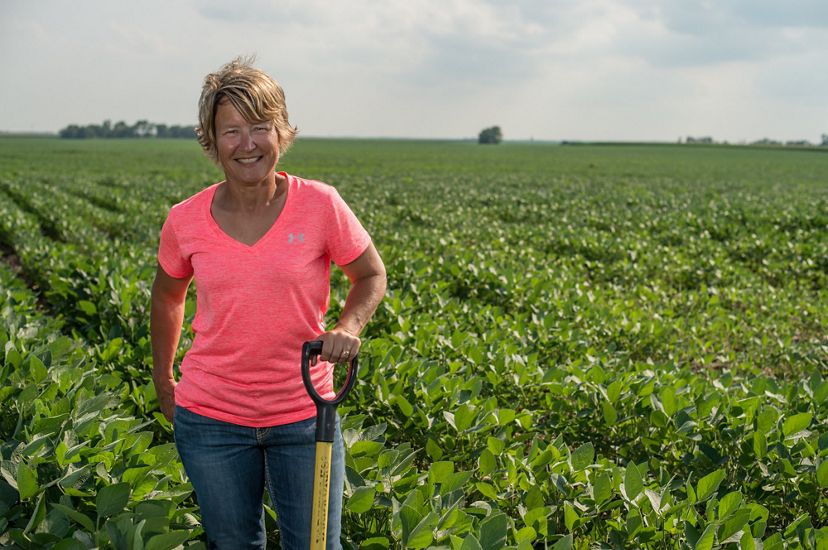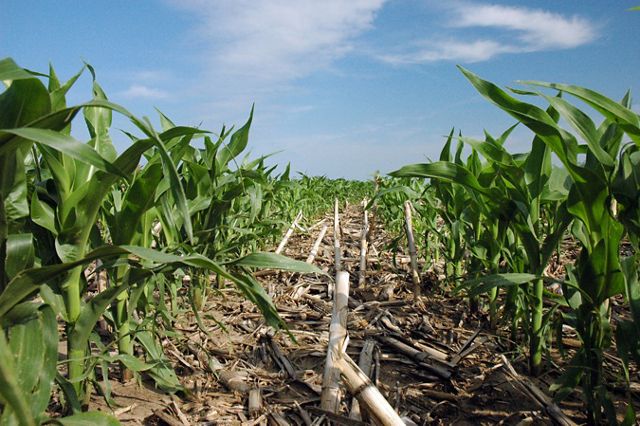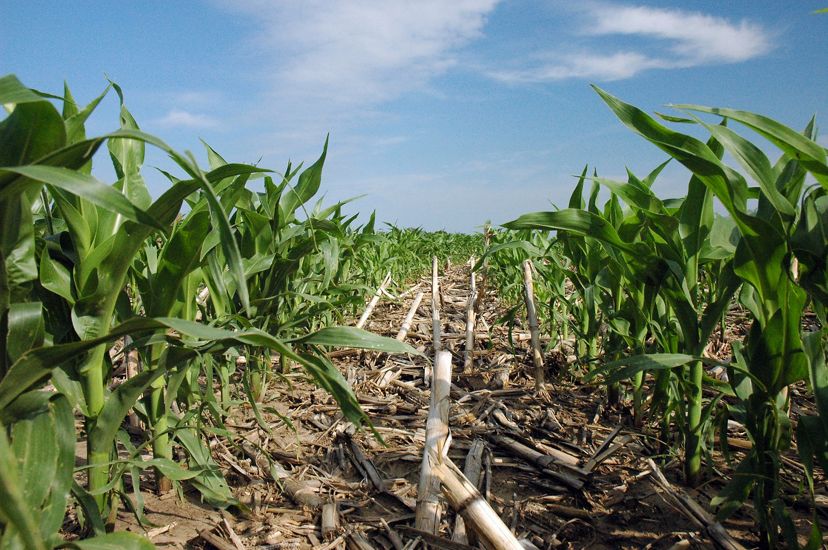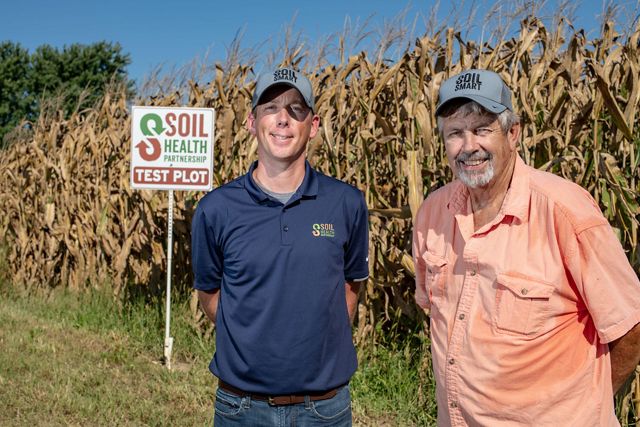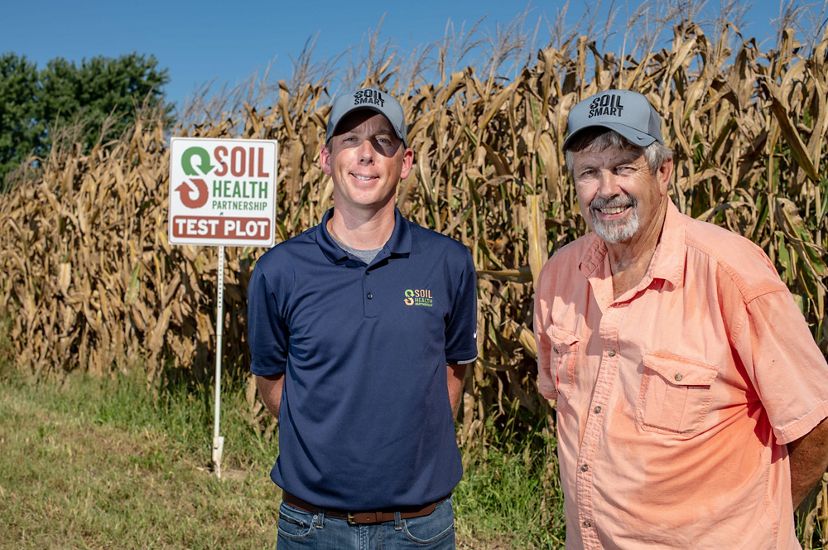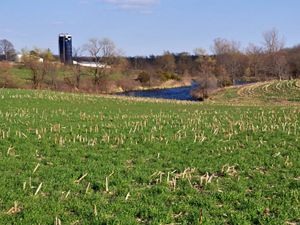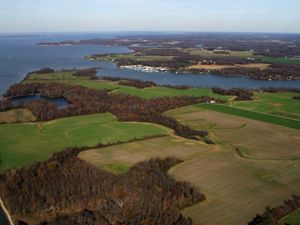Advancing Soil Health Through Partnerships
Soil Health Institute, Soil Health Partnership and TNC are collaborating to advance soil research, improve the environment and benefit farmers.
By Pipa Elias, Former Director of Agriculture, North America, The Nature Conservancy; Wayne Honeycutt, President and CEO of the Soil Health Institute; and John Mesko, Senior Director, Soil Health Partnership
There are more than 2 million farms across the United States, tended by men, women and families who produce the crops that feed, fuel and clothe the world. They care deeply for the lands and waters that sustain their livelihoods, but as the global population continues to grow, our nation’s farmers are under increasing pressure to produce more crops while also protecting the environment.
Fortunately, farmers also hold the key to solving some of our greatest conservation challenges—by rebuilding healthy soil. One of the most diverse habitats on earth—and one of the planet’s largest reservoirs of carbon—healthy soil is crucial for food production, clean and abundant water supplies and a stable climate.
In 2017, the Foundation for Food and Agriculture Research (FFAR) recognized the importance of healthy soil when it awarded a $10 million grant over three years to the Soil Health Institute (SHI), the Soil Health Partnership (SHP) and The Nature Conservancy to advance soil health science, research and education. Matched by foundations, leading companies, a commodity group and others, this award represents a total investment of nearly $20 million—one of the largest private investments in soil health to date.
During the past three years, SHI, SHP and TNC formed a strong partnership, with each organization bringing their unique expertise to the table and leveraging one another’s strengths to effect positive change on U.S. farms. The generous support of FFAR and the matching funders has enabled our collaboration to make tremendous strides, as evidenced by the milestones described below. (Click here to download a PDF of the infographic below.)

Understanding Soil Health in North America
Soil health is a critical component of a productive and sustainable agricultural system, but there is no widely accepted, standardized way to measure it. The Soil Health Institute is evaluating more than 30 different measurements to provide the scientific evidence necessary for recommending which measurements are the most helpful for farmers and ranchers.
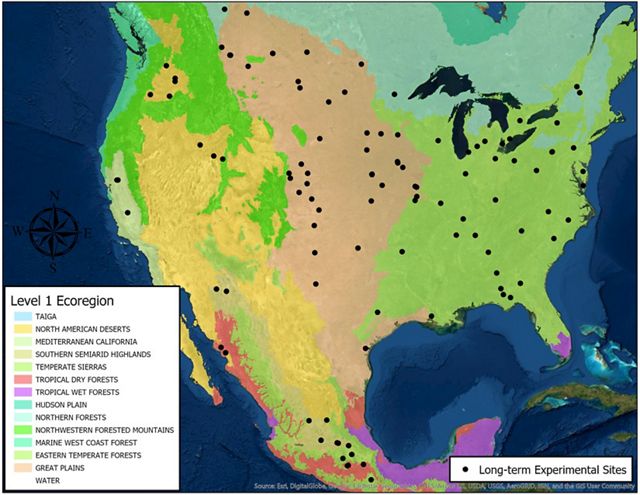

SHI scientists have collected more than 2,000 samples from 124 long-term experimental research sites throughout Canada, Mexico and the United States. The data generated from these samples will help determine which measurements can give farmers and ranchers the most accurate insight into the overall health of their soils and how they contribute ecosystem services such as sequestering carbon, protecting water quality and enhancing biodiversity. SHI also is evaluating the profitability of soil health management systems in both research and on-farm settings to help establish the business case for adopting soil health practices.
In 2020, SHI presented the preliminary results of its evaluation of soil health measurement to a wide variety of academic and non-academic entities. Analysis of these measurements has provided data that are being used to establish a minimum suite of standardized measurements, which can be used together to describe the soil's ability to perform specific functions. These standardized measurements now are being used to assess how soil health management practices influence environmental and economic outcomes, with particular attention to nutrient, carbon, and water cycling.
These soil functions offer solutions to global issues, like strengthening food and nutrient security, building a resilient climate and protecting water quality. Standardizing soil health measurement brings a better understanding of soil health in North America and builds the case for adopting soil health systems that benefit everyone. The project’s first publication, “Introducing the North American project to evaluate soil health measurements,” describes the rationale, approach and methods used, and it documents the core strategic design, soil health measurements being evaluated, methods used and sites participating in the U.S., Canada and Mexico.
Advancing Soil Health on Rented Farmlands
Many farmers do not own the land they work, but instead rent from landowners that do not farm themselves. In fact, non-operating landowners own 62 percent of Midwest farmland. A 2019 TNC report cites research that indicates a clear opportunity to introduce conservation into conversations between farmers and landowners. Understanding the extent of this opportunity and the complexity of increasing conservation practices on rented farmland, TNC is working to help facilitate productive “Conservation Conversations” between farmers and NOLs in Illinois, Indiana and Iowa—states where NOL farmland ownership is particularly high. For instance, TNC collaborated with Trust in Food to develop resource guides for landowners and farmers, and then worked with media, commodity groups and others to distribute the guides. Together, NOLs and their farmers have the power to transform the agriculture system, ensuring a healthier landscape for growing our food and safeguarding our drinking water supplies. Learn more about resources that help farmers and landowners talk about how they can partner on conservation.
Mapping a Sustainable Future
The Nature Conservancy is partnering with the Conservation Technology Information Center and Dagan, Inc. to map region-scale trends in adoption of soil health practices across the U.S. Corn Belt. Data for 2005 through 2018 were released in 2019. The Operational Tillage Information System (OpTIS), developed by scientists and engineers at Dagan, uses publicly available remote-sensing data to measure the adoption of cover crops, reduced tillage or no-till, and crop rotation in a large-scale, systematic and cost-effective way. OpTIS data, available at no cost, indicate that overall adoption of soil health practices is steadily increasing. Stakeholders like government agencies, academic researchers and supply chain companies can use this data to inform policy development, help improve farmers’ productivity and ensure a sustainable future. Learn more about OpTIS and its potential to unlock soil health solutions for the agriculture industry and conservation benefits for people and nature. And view two recordings of webinars about the capabilities of OpTIS.
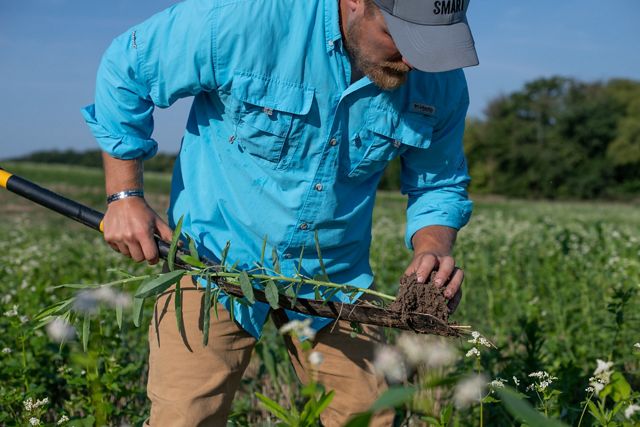

Building a Robust Research Network of Farmers
With the goal of increasing wide-scale adoption of soil health practices through farmer-to-farmer networking, SHP is working alongside more than 220 farmers in 16 states, spanning from North Dakota to Florida. Farmers work with an experienced field manager in their region to design a trial that compares a soil health practice to a current management practice to enhance sustainability and farm economics. Through strong outcome-based collaborations, SHP has seen greater awareness and adoption of soil health practices.
Developing and Leveraging Soil Health Research Data
Since the program began in 2014, SHP has strengthened existing research and expanded the SHP team to maintain quality data collection and farmer engagement. SHP’s work is helping industry adopt standardized measurements to evaluate and improve soil health while increasing access to education and tools for local farmers, agronomists and landowners. SHP partners with more than 120 organizations at the federal, state and county level including state government, commodity associations, nonprofits, foundations and private companies. Bringing together broad and diverse partners to work towards common goals, SHP is serving a larger audience of growers with localized support and resources.
By combining and integrating each organization’s strengths, Soil Health Institute, Soil Health Partnership and TNC are making significant progress on research and education efforts to advance the adoption of soil health on farms across the United States. Achieving our goal of widespread adoption will not only improve soil productivity and resilience but will also lead to economic benefits for U.S. farmers, contribute to clean water and a stable climate for generations to come.
Pipa Elias is Director of Agriculture for The Nature Conservancy in North America, Dr. Wayne Honeycutt is President and CEO of the Soil Health Institute, and John Mesko is Senior Director, Soil Health Partnership.
